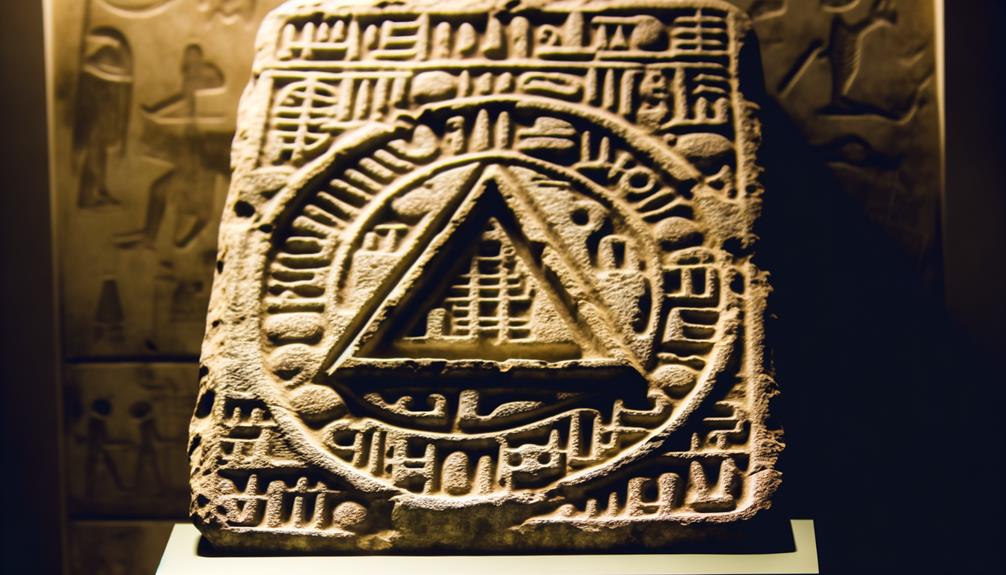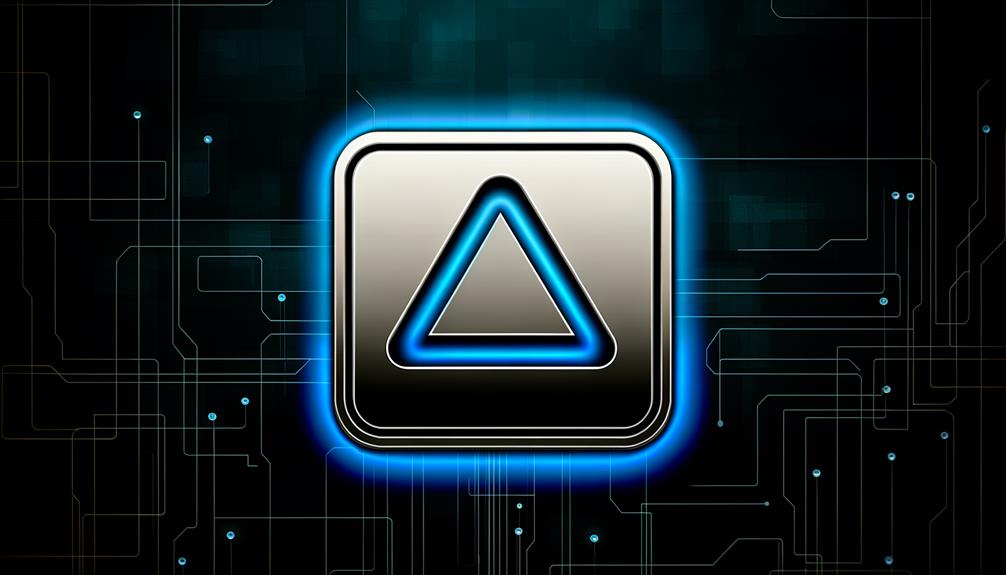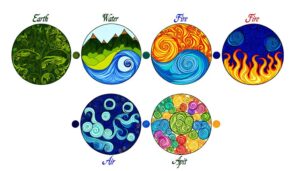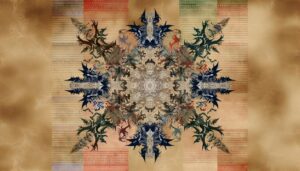What Is the Meaning of the Upside Down Triangle Symbol Across Cultures?
The upside-down triangle symbol holds rich historical and cultural significance. In ancient Greece, it represented feminine energy and water, while alchemical traditions linked it to processes of dissolution and purification.
It symbolizes fluidity, intuition, and the subconscious, and embodies cyclical existence and transformation. In modern contexts, it has been reclaimed by the LGBTQ+ community as a symbol of pride, strength, and resistance against oppression.
Artists and activists alike use it to challenge norms and convey unity. This versatile motif continues to evolve, reflecting complex histories and contemporary struggles, from ancient spirituality to modern social movements.
To uncover more subtle nuances, explore further insights into its varied interpretations.

Key Takeaways
- The upside-down triangle is linked to feminine energy and water in ancient Greek symbolism.
- It represents transformation, balance, and interconnectedness in alchemical and spiritual traditions.
- In the LGBTQ+ community, it symbolizes pride, defiance against oppression, and solidarity.
- Artists use it to depict instability, conflict, and personal growth.
- It signifies change and reevaluation of norms across various cultural and historical contexts.
Historical Significance

The upside-down triangle symbol has held varied and profound significance throughout history, often representing concepts of inversion, challenge to norms, and shifts in perspective across different cultures and eras.
In ancient Greece, the inverted triangle was linked to feminine energy and the element of water, signifying receptivity and emotional depth.
During the medieval period, it was employed in Christian iconography to denote the Holy Trinity's descent into the material world.
Indigenous cultures in the Americas saw it as a representation of female deities and fertility.
The symbol's recurring appearances in these diverse contexts highlight its role in embodying transformative ideas and challenging established conventions, providing a visual metaphor for change and the reevaluation of societal structures.
Alchemical Representation
In the world of alchemy, the upside-down triangle symbol is mainly associated with the element of water, signifying fluidity, intuition, and the subconscious.
Historically, alchemists used this symbol in their texts and experiments to represent the transformative processes of dissolution and purification.
Such symbolic transformations are essential to understanding how alchemists conceptualized and sought to manipulate the natural elements to achieve their philosophical and material goals.
Elemental Water Symbolism
Alchemical traditions often depict the elemental water symbol as an inverted triangle, symbolizing fluidity, intuition, and the primordial source of life. This representation aligns with water's natural properties—its adaptability and ability to conform to any container. Historically, water has been associated with the feminine principle, reflecting nurturing and emotional depth.
Alchemists saw water as a transformative agent, essential in their quest for purification and the philosopher's stone. The inverted triangle, pointing downward, signifies descent into the subconscious and connection to the earth, embodying the introspective qualities water invokes. Therefore, the elemental water symbol serves as a profound metaphor for the cyclical nature of existence and the continuous flow of transformation within alchemical practices.
Historical Alchemy Usage
Throughout history, alchemists employed the inverted triangle symbol to encapsulate the transformative and mystical qualities of water within their esoteric practices. This symbol was essential to their understanding of the natural world and the pursuit of transmutation. The inverted triangle, representing the element of water, was imbued with significant meaning:
- Purification: Water's ability to cleanse impurities resonated with the alchemical goal of achieving spiritual and material purity.
- Transformation: Alchemists viewed water as a medium for change, vital in the process of turning base metals into noble ones.
- Feminine Principle: The symbol was linked to the feminine, embodying qualities of intuition, emotion, and the subconscious.
- Fluidity: Water's adaptive nature highlighted alchemists' beliefs in the fluid and dynamic aspects of transformation.
This symbol's usage underscores alchemy's rich symbolic language and mystical undertones.
Symbolic Transformations
The inverted triangle's significance extended beyond water, serving as a fundamental component in the broader alchemical framework of symbolic transformations.
Historically, alchemists regarded this symbol as representing the feminine principle, earth, and the descent into matter. It was often juxtaposed with the upright triangle, symbolizing fire and the masculine principle, to convey the harmonization of opposites.
This interplay was central to the alchemical process of transmutation, aiming to achieve the philosopher's stone or enlightenment. The inverted triangle also symbolized the alchemical stage of dissolution, where substances were broken down to their essence.
Through this lens, the upside-down triangle was not merely a symbol but a key to opening the deeper mysteries of transformation and self-realization.
Spiritual Symbolism

In spiritual traditions, the upside down triangle often symbolizes elemental forces, particularly water and earth, reflecting their grounding and nurturing aspects.
Historically, it has been used to represent balance and harmony, highlighting the interconnectedness of the physical and spiritual domains.
This geometric shape serves as a visual metaphor for the equilibrium necessary to achieve spiritual enlightenment and inner peace.
Elemental Representation
Often associated with water and earth, the upside-down triangle symbol has long served as a powerful emblem in various spiritual traditions. In elemental representation, this geometric figure encapsulates the essence of these foundational elements, reflecting their inherent qualities and contributions to life and spirituality.
- Water: Symbolizes intuition, emotion, and the subconscious, often linked to feminine energy and fluidity.
- Earth: Represents stability, grounding, and sustenance, embodying the nurturing aspects of the physical world.
- Alchemical Traditions: Used to signify the mutable, transformative nature of water and earth in processes of change and growth.
- Cultural Interpretations: In diverse cultures, the symbol is utilized in rituals and iconography to evoke protection, fertility, and the cyclical nature of existence.
This enduring symbol offers a nuanced lens through which to explore elemental forces.
Balance and Harmony
Serving as a potent emblem of equilibrium, the upside-down triangle symbol encapsulates the spiritual principles of balance and harmony. Historically, this geometric shape has been associated with the feminine energy and the element of water, representing fluidity, intuition, and emotional clarity.
Its inverted orientation suggests a grounding force, inviting energies to flow downward, thereby fostering a sense of stability and inner peace. In various spiritual traditions, the upside-down triangle signifies the harmonization of opposites—merging the material with the spiritual, the conscious with the subconscious.
This convergence underscores the importance of maintaining equilibrium within one's life, advocating for a holistic approach to personal and spiritual growth. Such symbolism encourages individuals to seek a balanced state of being amidst life's inherent dualities.
LGBTQ+ Community Meaning
The upside-down triangle has evolved from a symbol of oppression during the Holocaust to a powerful emblem of pride and resistance within the LGBTQ+ community. Initially used to identify homosexual prisoners in concentration camps, the pink triangle was reclaimed by activists in the 1970s to confront and transform its historical significance.
This act of reclamation symbolizes:
- Pride: An assertion of identity and defiance against discriminatory forces.
- Resilience: A reminder of the community's enduring strength and perseverance.
- Solidarity: A unifying emblem that connects diverse individuals within the LGBTQ+ spectrum.
- Activism: A call to action, highlighting ongoing struggles for equality and justice.
The upside-down triangle serves as a sign of the community's journey from marginalization to empowerment.
Artistic Interpretations

Artists have continually reinterpreted the upside-down triangle, infusing it with diverse meanings that reflect its complex history and evolving significance.
Historically rooted in alchemical symbolism, where it represented the element of water, the inverted triangle has transcended its original context.
In modern art, it has become a versatile motif, symbolizing inversion, subversion, and transformation. Some contemporary artists use it to challenge traditional power structures, while others embed it in geometric compositions to explore balance and symmetry.
The shape's simplicity allows for multifaceted interpretations, ranging from the abstract to the deeply personal.
Consequently, the upside-down triangle serves as a dynamic symbol in artistic expression, continually evolving to encapsulate shifting paradigms and nuanced perspectives.
Cultural Variations
Across different cultures, the upside-down triangle has acquired a variety of meanings, each shaped by unique historical, social, and spiritual contexts. In ancient Greek civilization, it symbolized water, a crucial element associated with life and fluidity.
In Hinduism, the inverted triangle represents the feminine energy or Shakti, embodying fertility and creation.
- Ancient Greece: Symbolized water and fluidity.
- Hinduism: Represents Shakti, the feminine energy.
In alchemy, the upside-down triangle denotes the element of water, considered essential for transformation.
- Alchemy: Denotes the element of water, essential for transformation.
Within Native American cultures, the upside-down triangle signifies the element of water and its life-giving properties.
- Native American Cultures: Signifies the element of water and its life-giving properties.
These cultural variations highlight the symbol's versatility, indicating how interpretations can evolve based on differing societal values and spiritual beliefs. Each context contributes to a richer understanding of this ancient geometric symbol.
Modern Uses

In contemporary contexts, the upside-down triangle continues to serve as a potent symbol, often seen in fields such as design, fashion, and social movements.
In design, it is employed to convey instability or dynamism, countering the stable connotations of its upright counterpart. Fashion designers utilize this geometric form to evoke avant-garde aesthetics and challenge traditional silhouettes.
Social movements, particularly those advocating for LGBTQ+ rights, have adopted the inverted triangle to signify resistance and solidarity, tracing its reclamation back to its use during World War II to label marginalized groups.
This multifaceted symbol's modern applications reflect a blend of historical legacy and innovative reinterpretation, underscoring its enduring versatility and powerful visual impact in contemporary society.
Psychological Perspectives
The upside-down triangle, from a psychological perspective, often evokes notions of imbalance, tension, and metamorphosis, serving as a powerful visual cue that can invoke a range of emotional and cognitive responses.
Historically, this symbol has been associated with various interpretive meanings, reflecting:
- Instability: Its inverted form suggests a lack of equilibrium.
- Conflict: It can symbolize internal or external discord.
- Change: A shift from the norm, often indicating a transformation or upheaval.
- Feminine Energy: Historically linked to the feminine, contrasting the upward triangle's masculine connotation.
In modern psychology, this symbol can be utilized to explore themes of personal growth, challenge, and the dynamic nature of human experience. Understanding these associations enriches our grasp of its broader significance.
Conclusion
The upside-down triangle symbol, much like a prism refracting light into myriad colors, embodies a spectrum of meanings across various domains. Its historical roots in alchemy, spiritual connotations, and significant role within the LGBTQ+ community reflect its multifaceted nature.
Artistic and cultural interpretations further enrich its significance, while modern applications and psychological perspectives underscore its enduring relevance. This symbol's versatility and depth continue to inspire and inform across disciplines and societies.





